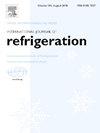IF 3.5
2区 工程技术
Q1 ENGINEERING, MECHANICAL
International Journal of Refrigeration-revue Internationale Du Froid
Pub Date : 2025-02-06
DOI:10.1016/j.ijrefrig.2025.02.002
引用次数: 0
摘要
解冻泡菜的方法对于决定冷冻泡菜产品的最终质量至关重要。虽然许多研究已经探索了各种解冻技术,但专门针对冷冻泡菜解冻过程的研究仍然有限。本研究调查了自然空气解冻(NT)、冰箱解冻(RT)、流水解冻(RWT)、微波解冻(MWT)和射频解冻(RFT)对冷冻泡菜质地、水分含量和生物特性的影响。泡菜被包装成 100 克、200 克和 300 克的单位,结果显示,不同包装规格和解冻方法的解冻损失、水分含量和质地都有显著差异。MWT 导致最大的水分损失(高达 14.36%)和最广泛的微生物降解,而 RT 和 RFT 则有效地保持了水分、质地和生物活性化合物,且质量劣化程度最小。总之,在所有解冻方法中,包装尺寸越大,解冻损失越大,微生物存活率越低。这些发现强调了选择适当解冻技术的重要性,以保持泡菜在冷冻储存和销售过程中的质量。本文章由计算机程序翻译,如有差异,请以英文原文为准。
Impact of thawing methods and packaging sizes on the physicochemical and microbial quality of frozen kimchi
The method used for thawing kimchi is crucial in determining the final quality of products made from frozen kimchi. While many studies have explored various thawing techniques, research specifically focused on the thawing process of frozen kimchi remains limited. This study investigated the effects of natural air (NT), refrigerator (RT), running water (RWT), microwave (MWT), and radio-frequency thawing (RFT) on the texture, moisture content, and biological properties of frozen kimchi. Kimchi was packaged into 100-, 200-, and 300 gram units, revealing significant differences in thawing loss, moisture content, and texture across both package sizes and thawing methods. MWT resulted in the greatest moisture loss (up to 14.36 %) and the most extensive microbial degradation, whereas RT and RFT effectively preserved moisture, texture, and bioactive compounds with minimal quality deterioration. Overall, larger package sizes were associated with increased thawing losses and decreased microbial viability across all thawing methods. These findings highlight the importance of selecting appropriate thawing techniques to maintain the quality of kimchi during frozen storage and distribution.
求助全文
通过发布文献求助,成功后即可免费获取论文全文。
去求助
来源期刊
CiteScore
7.30
自引率
12.80%
发文量
363
审稿时长
3.7 months
期刊介绍:
The International Journal of Refrigeration is published for the International Institute of Refrigeration (IIR) by Elsevier. It is essential reading for all those wishing to keep abreast of research and industrial news in refrigeration, air conditioning and associated fields. This is particularly important in these times of rapid introduction of alternative refrigerants and the emergence of new technology. The journal has published special issues on alternative refrigerants and novel topics in the field of boiling, condensation, heat pumps, food refrigeration, carbon dioxide, ammonia, hydrocarbons, magnetic refrigeration at room temperature, sorptive cooling, phase change materials and slurries, ejector technology, compressors, and solar cooling.
As well as original research papers the International Journal of Refrigeration also includes review articles, papers presented at IIR conferences, short reports and letters describing preliminary results and experimental details, and letters to the Editor on recent areas of discussion and controversy. Other features include forthcoming events, conference reports and book reviews.
Papers are published in either English or French with the IIR news section in both languages.

 求助内容:
求助内容: 应助结果提醒方式:
应助结果提醒方式:


